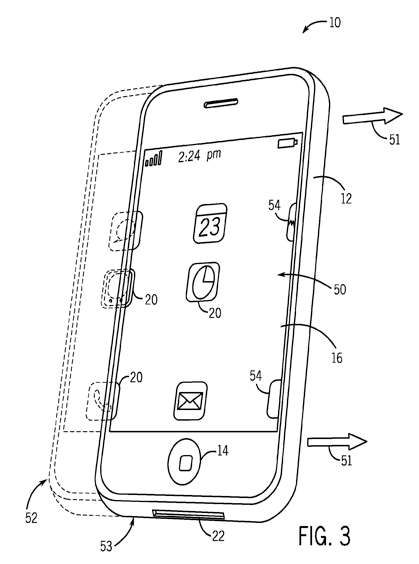Apple exploring motion compensation in mobile screens
Originally filed in February of 2008, the application describes various methods which might make handling a touchscreen device or viewing a mobile screen easier as the device moves about, whether on a moving vehicle or walking about. The document details a number of ways this problem could be solved, including display adjustment using motion data and screen properties, scaling selectable images, varying the input region on a touchscreen device, or including pressure values and location values.
"The instability, whether produced by the environment or the user, may cause user interface challenges," the patent application reads. "For example, a vibrating screen may make it difficult for a user to view images on the screen. Similarly, a moving screen or input object may make it difficult for a user to select an item on a touch screen."
The patent application describes different scenarios in which this technology could be helpful, from typical experiences to highly unique circumstances.
"The screen may be part of a system used in a high vibration environment such as a tank monitoring and control system for a chemical processing plant or a personal entertainment system located within an airplane seat back," the patent reads. "Similarly, the screen may be part of a portable electronic device that is accessed in an unsteady environment such as a subway or moving vehicle. In another example, the screen may be part of a device used by a user with limited or impaired motor control."
The filing is similar to one revealed by AppleInsider earlier this year that described an iPhone-like device with a front-facing video camera with software that would adjust itself while in motion. That application described technology that would detect "signatures of motion," to which the iPhone software would adjust by enlarging areas on the screen making them easier to see and touch.
In another patent filing, Apple describes a method to use a Bluetooth module to process non-Bluetooth signals. The document details how a device might be able to process signals received from a source that uses a different set of data rates, or conversely how a device might be able to transmit similar signals.
It goes on to say that a non-Bluetooth transmitter could potentially send out a non-Bluetooth signal at a data rate a Bluetooth receiver could read.
"A Bluetooth receiver, such as a portable media player or smart phone with Bluetooth circuitry, can receive the non-Bluetooth signals sent at the particular data rate using the Bluetooth circuitry," the document reads. "In one embodiment, the Bluetooth receiver can "over-sample" the signal or transmission of the non-Bluetooth packet sent at the particular data rate using one or more data rates associated with the Bluetooth circuitry."
Finally, another patent application revealed this week demonstrates a method to transform one complex programming language into another automatically. The document notes that techniques for bridging data between different programming languages currently exist, however, they do not provide functionality for converting more complex data into a different language.
"For example, a linked list object defined in a first programming language often has no direct transformation to a corresponding list data structure supported by a second programming language," the application states. "Thus, an improved technique for transforming data structures between programming languages or systems is needed."
 Neil Hughes
Neil Hughes











 Andrew Orr
Andrew Orr
 Wesley Hilliard
Wesley Hilliard
 Amber Neely
Amber Neely

 William Gallagher
William Gallagher

 Malcolm Owen
Malcolm Owen








